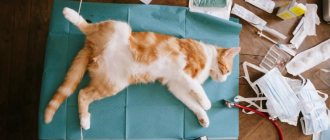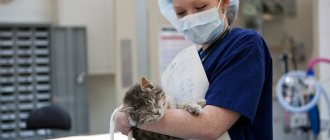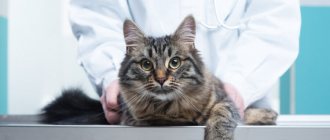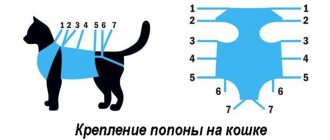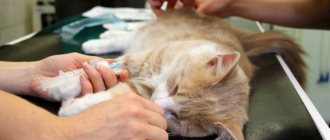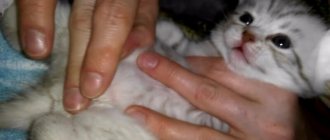Veterinarians strongly recommend sterilizing domestic cats in order to regulate their behavior and control the population. This especially applies to urban animals. Castration of a cat and sterilization are not the same thing. During castration, the gonads are removed entirely; during sterilization, the pathways of sperm in British males and the fallopian tubes in females are stopped. Both operations make it impossible for a British man or woman to reproduce.
The difference is that with complete removal of the reproductive organs, sex hormones cease to be produced, and the pet no longer strives to mate. After sterilization, sexual instincts continue to manifest themselves.
Procedure of castration, ovariohysterectomy
Castration of cats is carried out in order to stop the production of sex hormones until the reproductive instinct completely disappears. Castration can be done surgically or with medication. Surgery to remove testes from the scrotum or abdomen requires general anesthesia. The medical method consists of implanting a subcutaneous implant (Suprelorin) and is performed under local anesthesia. Both methods lead to the cessation of testosterone production, suppression of sexual instincts, and correction of the animal’s behavior.
For cats, castration (ovariohysterectomy) involves the removal of the internal genital organs: the uterus, ovaries, and fallopian tubes. The operation protects against uncontrolled mating and reduces the risk of reproductive cancers.
Photo - the genitourinary system of a cat
conclusions
Each of the castration methods described in the article has the right to life, since all these methods have significantly more advantages when compared with the number of disadvantages. But still, veterinarians still rarely use any type of sterilization without removing the testicles. And this is completely justified. The fact is that it is the surgical removal of the testes that provides a 100% guarantee of stopping sexual function and prevents the development of many diseases (including testicular cancer, orchitis, etc.).
Important! When the testes are physically removed, the animal becomes noticeably calmer, and the cat lives much longer.
But the final decision must be made by the owner of the animal, after consulting with a veterinarian.
Why is castration (sterilization) necessary?
Why castrate? If a cat is constantly staying (living) in the enclosed area of a city apartment, the needs dictated by libido are a regular source of concern for the animal and the owners. The animal gets nervous, tries to mark its territory, and makes loud beeps at the most inopportune times of the day. If the cat is not intended to reproduce and cannot satisfy this natural need, castration is the only possible solution.
In a sterilized cat, the production of estrogen (the hormone of sexual activity) is blocked. This effect prevents the development of low-quality tumors of the mammary glands, uterus or ovaries in the pet.
Let's summarize the positive effects of castration. What does a castrato look like and behave after surgery:
- Becomes calm and affectionate;
- No longer marks territory;
- Does not try to escape from the house through the doors or out the window;
- There is no risk of contracting a viral infection;
- Protected from prostatitis, adenoma and other tumors.
These factors together contribute to increasing the pet's life expectancy.
Negative consequences of the procedure (cons):
- Probability of urolithiasis;
- Weight gain and cardiac diseases as a result of decreased activity;
- In older animals, complications from anesthesia are possible, so it is recommended to operate before the age of three.
Reasons to spay females (pros):
- Birth control;
- Correction of behavior (during periods of sexual activity, the female is restless, loses appetite, and marks her territory);
- Protection against infections.
Risks associated with sterilizing a female:
- the likelihood of complications during anesthesia;
- sterilized individuals are sedentary and prone to obesity.
Photograph of a cat's genitourinary system
Obesity prevention
Many owners are concerned about the question: what needs to be done to prevent their pet from gaining weight? Everything is quite simple: you need to reduce the usual portion by 10-20%. If the cat eats industrial food, you can replace the usual food with specialized food for castrates (in this case, there is no need to reduce the portion, since such food is balanced in composition). It is not recommended to feed the cat the same foods that are harmful to any cat: raw fish, fatty and salty foods, sausages, flour, sweets.
Recommended age for sterilization (castration) procedure
What time is castrated - the period from seven to nine months of life of a young British kitten is considered the most suitable for the operation (optimal age).
During the first six months of life, the cat grows vigorously, gains weight, builds up muscles, and the musculoskeletal system of the body develops and forms. Therefore, castration is not advisable before six to seven months. To be ripe for the procedure, a cat must cross a weight threshold of 1.5 - 2 kilograms. If the boy is a representative of a large cat breed (Kurilian Bobtail, Neva Masquerade), he can reach a weight of 3 kg a little earlier than 7 months.
Having reached the age of nine months, the cat turns into a sexually mature male. If you delay castration, the residual hormone levels will not go away immediately after the operation and the positive effects will manifest themselves with a delay.
Veterinarians recommend sterilizing a girl between the ages of 6 - 7 months (possibly earlier - at 4 - 5 months) to 9 - 10 years. It is not recommended to postpone the operation for a long time, since unsterilized cats that remain without mating increase the risk of diseases of the genital organs, which is not immediately clear.
Is it possible to castrate an adult British cat at 11, 12 - 13 years old? For older animals of both sexes, surgery is fraught with complications from anesthesia. Their castration should be approached with special responsibility. Preoperative preparation should include a full-scale diagnosis of internal organs (ultrasound, cardiogram, blood test for biochemistry).
Anesthesia
Castration of a cat lasts no more than five minutes. However, for humane reasons, any surgical intervention is performed using anesthesia. Surgeries are not performed without general anesthesia.
Types of pain relief:
- non-inhalation;
- inhalation;
- local anesthesia
The listed methods are often used in combination.
Non-inhalational anesthesia. This type of pain relief is used most often. To achieve the effect, a combination of medications that inhibit pain sensitivity (ketamine) and muscle relaxants (xyl, meditin, etc.) is used. The duration and depth of the anesthetic effect depends on the dosage of medications and is calculated depending on the weight of the animal. This type of pain relief is used in clinics and when performing surgery at home.
Representatives of breeds predisposed to cardiac pathologies undergo a preliminary examination. This applies to the Don Sphynx, Kuril Bobtail, British Shorthair and Scottish cat breeds.
Inhalation anesthesia. A gas mixture of anesthetics (isoflurane, fluorothane, cyclopropane, nitrous oxide) is supplied to the animal’s respiratory system. This method is considered the least dangerous in veterinary medicine, since the medications enter and exit naturally. The intensity of drug administration is controlled by the cat’s body itself: when breathing is suppressed, the process is inhibited, reducing the dose of the substance entering the lungs. The kidneys are not involved in the process, so it can be used for older individuals. The disadvantage of this method is the need for inhalation equipment and high cost.
Local anesthesia. Novocaine or lidocaine is injected under the skin (into the spinal cord) of the cat. The method is rarely used, since the animal remains conscious, actively resisting the surgeon.
Combined anesthesia. For our little brothers, any anesthesia is a complex (scheme) of several methods. To prevent the patient from resisting the manipulations, he must first be put to sleep or his muscle reflexes inhibited.
Blanket on a short-haired cat
Types of anesthesia
For castration, local or general anesthesia is used. Local anesthesia is used locally, on a specific area of the body, or the anesthetic is injected into several points on the body. After local anesthesia, the pet’s body recovers faster. Anesthesia is administered using a syringe.
General anesthesia involves certain risks to your pet's health. Before applying general anesthesia, the animal must be examined and checked for failures and disturbances in the functioning of the cardiovascular system.
During general anesthesia, anesthesia is administered in two ways:
- Injection method - the medication is administered intramuscularly or intravenously. Intravenous administration provides a quick effect and you can begin to act in 1 – 2 minutes. When administered intramuscularly, the anesthesia begins to act only after 20 minutes. This method can cause complications on the body. As a rule, it is used in relation to aggressive animals.
- The inhalation method involves administering anesthesia through the lungs. This type of anesthesia causes virtually no harm to the body. The risks are minimal. Recovery from anesthesia occurs in 3–4 minutes.
A combined method of anesthesia can also be used for castration. When it is necessary to immobilize a pet, they first use a sedative and then insert a tube into the mouth (in the case of the inhalation method).
How to prepare an animal for surgery?
To ensure the normal course of the operation, the veterinarian prescribes a set of preliminary tests: ultrasound, blood test, consultation with a cardiologist, vaccinations according to age. These measures are especially important for older animals, since the aging process leads to the accumulation of irreversible changes in the body.
The entry of food into the animal’s body before surgery should be excluded. The cat can be fed for the last time twelve hours before surgery, and given water no less than three hours before. The intestines must be empty at the time of surgery, otherwise the anesthesia will cause uncontrollable vomiting.
Choosing a cat castration method
There are the following types of cat castration:
Surgical involves removing the seminal glands. Two small incisions are made on the skin of the scrotum, through which the testes (eggs) are removed. To stop the flow of blood from opened vessels, the surgeon can:
- tie the spermatic cord with surgical thread;
- tie the rope into a knot.
Chemical is carried out by implanting an implant under the skin of a cat with a substance that temporarily (up to 3 years) blocks the production of sex hormones. This method is chosen when the owner does not plan to permanently deprive the cat of the ability to give birth (gentle castration).
Using the chemical method has a defect. Immediately after implantation, the cat’s sexual desire increases (it may want a cat), and the accompanying unpleasant effects intensify for about three weeks.
A vasectomy is the ligation of the spermatic cords. The cat becomes sterile, but can mate and mark. This happens in catteries: a breeder performs a vasectomy on a cat specifically to bring the cats out of heat (often after the birth of kittens). Pros: A male cat cannot make kittens, no need to use hormonal pills for cats.
Temporary deprivation of reproduction
To temporarily suppress reproductive function, a Suprelorin implant is surgically implanted under the skin of the animal. The active ingredient is Deslorelin. About a month and a half after the procedure, the cat loses sexual desire and no longer pays attention to females.
One implant can work for at least a year. Despite all the advantages of this technique and the almost complete absence of side effects, it is not widespread in world veterinary practice. The main factor limiting the spread of this method of castration is the high cost of consumables. Not every breeder will agree to regularly shell out considerable sums if it is possible to carry out cheap and reliable surgical castration.
In addition (but there is no official confirmation yet), many veterinarians believe that Deslorelin, with long-term use, significantly increases the chances of testicular cancer. And other features of its constant use have not yet been studied.
Choosing a cat sterilization method
Sterilizing a cat leads to a decrease in the amount of sex hormones produced by its body. What is the difference between castration and sterilization, what is the difference, description below?
Ovariectomy (sterilization) and ovariohysterectomy (castration) . What does surgical sterilization of cats mean - removal of the ovaries, castration - removal of all genital organs. The first method is chosen for young cats that have not yet given birth, since the likelihood of damage to the uterus is low for them. The result of the operation is the emotional comfort of the pet and its owners, reducing the risk of neoplasms, and will help get rid of the marks.
Veterinarians advise complete castration with removal of the uterus. This is the most reliable way to regulate sexual heat, allowing you to protect the cat from complications associated with the development of purulent inflammation of the uterus.
Tubal ligation (occlusion) . This method removes reproductive ability, but leaves hormonal levels intact. The cat's sexual behavior remains the same after surgery, so such operations are performed infrequently.
Temporary castration with medication. If the owner wants to temporarily stop the cat’s hormone production, an implant is inserted under the cat’s skin. It performs the task of blocking hormones for 3 years. After this period, the cat will again be able to give birth.
How is surgical castration of a cat performed?
Step by step: after anesthesia, the hair on the skin at the operation site is shaved. After thoroughly treating with a disinfectant solution, a small incision is made through which the seminal glands are removed. The operation takes no more than 7-8 minutes.
Methods for sterilizing a cat
There are three main methods of performing surgery to remove the genital organs of a cat:
- Classic (along the white line). An incision ranging from one and a half to five centimeters in length is made in the central part of the abdomen below the navel. The peritoneal wall is incised between the muscles. After the uterus and ovaries are removed, the blood vessels are ligated with surgical absorbable suture. Sutures are placed on the peritoneal wall and skin. If no absorbable suture was used to place the stitches, they will need to be removed after two weeks. During this time, the animal must wear a medical blanket to protect the suture from infection.
- Side cut. This method does not require complex postoperative care for sutures. It is used to sterilize stray cats, which are released into the wild immediately after surgery. Most often, only the ovaries are removed using this method.
- The laparoscopic method is named after the instrument used for the operation. A laparoscope is a device for penetrating body cavities without traumatic damage to external tissues. To insert it into the body, you only need a tiny incision. The laparoscope is equipped with a video camera that helps the surgeon monitor the progress of the operation. To increase visibility during manipulations, the abdominal cavity is filled with carbon dioxide. The ovaries and uterus are removed through a small hole.
The advantages of this method include:
- practically painless;
- access to the abdominal cavity through a small puncture causes minimal tissue trauma;
- visual control at all stages of the operation;
- there is no possibility of infection;
- no postoperative care is required.
Due to the high cost of equipment, the laparoscopic method is more expensive, which all veterinary clinics cannot afford and there are no specialists with the necessary skills.
Any of the surgical methods requires the use of general anesthesia.
Postoperative sutures in cats
After sterilization, a suture is placed on the incision. When suturing the peritoneal wall, use catgut or synthetic absorbable threads. Postoperative care of the suture consists of periodic treatment with a disinfectant.
Classification of seams:
- The classic knot is reliable, but not flawless from an aesthetic point of view. Designed for a yard cat for which it is impossible to provide full supervision. Since she will try to remove the seam with her tongue, maximum strength is needed.
- Continuous interrupted skin suture - the doctor removes it 10 days after surgery. It does not cause too much damage to the skin and resolves after a few months.
- A continuous intradermal suture does not require removal. It is performed with a thread that will resolve (completely heal) a couple of months after the operation.
Radiation variety
Again, in our country this method of sterilizing cats is rarely practiced, which is a pity. During the procedure, the cat's testicles are fixed in a special isolating device and exposed to gamma radiation. On the one hand, this procedure is simple and requires very little time. After irradiation, the cells of the glandular tissue of the testes die, and the cat can no longer participate in reproduction. The use of anesthesia drugs is not required, the postoperative period passes in just a few hours.
The disadvantages of the technique include its high cost. In addition, there are very few veterinary clinics equipped to carry it out.
And one more thing: contrary to common “horror stories”, after such a procedure your cat will not begin to glow with a greenish light, and the radioactive background of his body will remain normal.
The processing time is only a few seconds. Gamma radiation does not leave “phoning” particles in the tissues.
Postoperative cat care
After the castration procedure, in the first days the cat requires additional attention and organization of care. Veterinarians, as a rule, suggest leaving the animal in the clinic until the effect of anesthesia ends (rehabilitation).
Rules to follow after surgery:
- Within 24 hours (on the first day) after castration, the cat should not be given food to avoid vomiting and subsequent inhalation of vomit. The animal can start drinking water four to six hours after waking up.
- The cat will not immediately regain control of movements and may fall off the table or sofa; anesthesia affects coordination. Before regaining consciousness, it is better to place the animal on the floor, laying down a diaper in case of arbitrary urine leakage.
- Make sure that the cat does not suffocate by burying her nose in something and blocking the air supply.
- Avoid exposure to bright light that irritates your vision when waking up.
- Medical anesthesia leads to a decrease in body temperature to one and a half degrees. If the room is cold, you need to take additional measures to protect the cat from hypothermia: cover it with a blanket and place it close to a heat source.
- Take care of your eyes. Until the cat finally wakes up and her blinking reflex is restored, periodically drip sterile liquid (saline solution, water for injection, antibacterial eye drops without antibiotics) into the conjunctival cavity of the eye.
- Ensure peace, limit contact with other animals and children, since the period after anesthesia is characterized by altered behavior. The aggressiveness of a cat is a temporary effect, there is no need to be scared; after a while, British cats behave as usual.
- Temporarily replace special cat litter with napkins or pieces of paper to prevent dispersed particles from getting into the wound.
- Monitor the condition of the wound. If there is discharge, dry the wound (treat it with a sterile cloth).
- Limit the animal's access to the surgical site. Clean cats will tend to lick the wound or seam, and this will slow down the healing process. Wearing a veterinary collar is recommended. This accessory will not interfere with eating, but will provide barrier protection for surgical sutures.
- Inspect the surgical site regularly, and if complications occur, consult a doctor immediately.
- In accordance with the doctor's prescription, treat with antibiotics.
The total duration of the recovery period after castration is up to 10 days. Boys tolerate surgery well in most cases.
Scheme of blankets for cats and dogs
Transportation
If we talk about the animal’s reaction to anesthesia, then in this case everything depends on its individual characteristics. Perhaps, already on the way to the house, the pet will begin to behave quite violently, since it will not understand what is happening to it. Therefore, you need to be extremely careful and make sure that the cat does not open the carrier.
Of course, in such a situation, in no case should you transport the animal simply in your arms or on a car seat. It is advisable that the pet lie on its side during transportation. Firstly, this allows him to rest a little, and secondly, in the event of vomiting, it will eliminate the possibility of vomit getting into his throat.
Behavior of an operated cat
A sterilized British cat will no longer go into heat. Otherwise, the character of the animal will remain the same with correction (changes) towards greater balance and obedience.
The Briton will continue to hunt, play and communicate with other pets and family members as before.
The cessation of sex hormone production leads to a gradual increase in appetite, resulting in obesity. You should consider a balanced diet for the animal, including specialized low-calorie food for castrated animals.
What complications can be expected after castration of a cat?
Complications after castration surgery are uncommon. Here is a list of problems, if they occur, you should definitely consult a doctor for advice and help:
- Blood from the wound. Excessive bleeding means damage to blood vessels. You need to contact your veterinarian immediately.
- Self-harm. To prevent the cat from licking the wound (licking less) and worsening its condition, it is enough to put on a medical collar for the first 3-4 postoperative period.
- The wound is festering or inflamed. This rare complication usually occurs if the operation was performed at home without following disinfection measures. It is necessary to consult a doctor to choose antibacterial treatment.
- A fistula is formed as a result of the body’s rejection of the surgical threads with which the suture was cut off.
- Difficulty urinating is not a direct consequence of castration. Diseases of the urinary system occur due to the formation of salt deposits in the bladder.
The cat continues to mark its territory after castration
Castration leads to the cessation of the production of sex hormones in the animal's body. Unpleasant effects associated with sexual desire cease quite quickly after the operation. There are (may be) exceptions to this general rule.
Possible reasons for this behavior:
- The period of reduction in hormone production dragged on. The decrease in hormone levels in the blood can take from three weeks to several months.
- Up to five percent of adult animals that have already had sexual intercourse will continue to leave marks. In their body, hormones continue to be produced in an alternative way (adrenal glands, pituitary gland).
- Surgeon's mistake. Perhaps the cat suffers from cryptorchidism, that is, one of the testes is in the abdominal cavity, and not in the scrotum.
- Urinary tract disease.
- Psychological reasons. The animal may simply prefer another place to correct its natural needs.
Urolithiasis disease
The disease is caused by the development of pathological processes in the urinary system and is characterized by the formation of salt deposits of various sizes in the bladder. Causes of salt formation: genetic predisposition, poor diet, low mobility, imbalance of salt in drinking water, infectious diseases, stress.
The physiological characteristics of males lead to the fact that this disease occurs much more often in them than in females. Both unsterilized and neutered animals are susceptible to the disease, but the latter are more likely to have urethral blockage.
Manifestations of urolithiasis, signs:
- plaintive meow;
- anxiety;
- frequent urination with small amounts of urine;
- decreased appetite;
- reduced water consumption.
A dangerous symptom is the cessation of urine output. Its accumulation in the kidneys can lead to fatal consequences.
Conservative treatment includes procedures to determine the severity of the disease, removal of urine from the body and changes in diet. In severe cases, surgery is required.
Proper nutrition for a neutered cat:
- purchase specially selected feed;
- categorically exclude fish and seafood products from the diet;
- ensure your daily water intake (approximately two hundred milliliters).
First day
During this period, the animal is most often disoriented, so it is advisable to cover the cat with a warm blanket and leave it alone so that it can sleep. You can also place a bottle filled with warm water next to it as a heating pad. It is recommended to place it along the animal's back. However, it is important to ensure that the perineum itself does not overheat. This can lead to inflammation or even bleeding. Therefore, you should also not place the animal near a radiator or other heating devices. It is very important to exclude drafts.
When caring for a cat after castration, make sure that for the first day he does not eat anything, only drinks.


